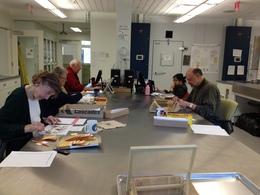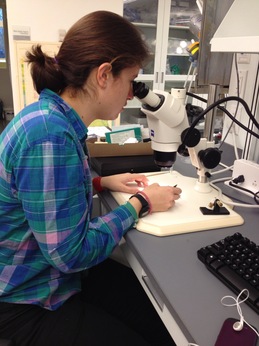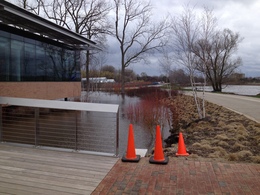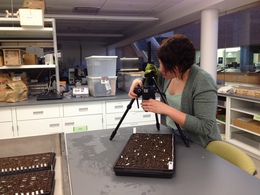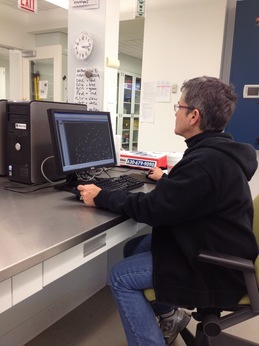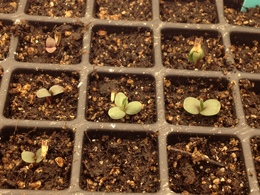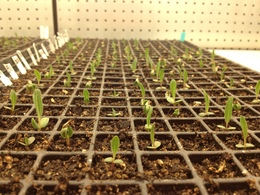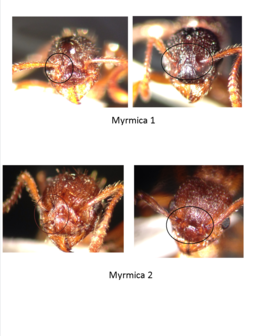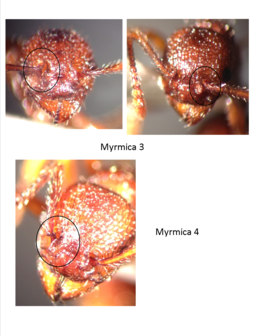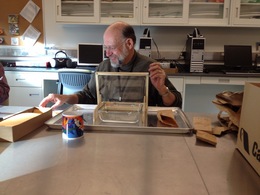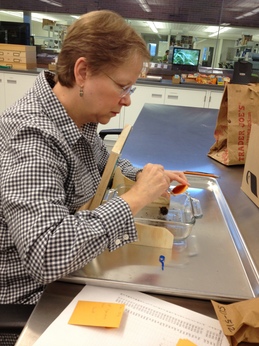The Thursday crowd is undertaking variety of tasks today: Bob (back left) is counting achenes using the new online data entry system, Char and Suzanne (left) are taking a random sample of achenes to weigh, Bill (front right) is extracting achenes from Echinacea heads, and Maria (back right) is working on her senior thesis on pollen limitation in a prairie grass. Gia (not shown) is identifying ants from the Staffenson prairie preserve.
|
||||
|
Hello! My name is Gia and I am one of the undergrads interning at the lab this quarter. I recently applied to the undergrad research expo that is held at Northwestern every year in May to try and present my findings about ant communities as part of the broader Echinacea project. Below is the abstract/ summary of my project that I sent in for the application. Katherine Muller, Stuart Wagenius Linking Prairie Ant Communities & Fire: The Effect of Fire on Ant Diversity in Prairie Remnants of Western Minnesota Research within the field of conservation emphasizes the maintenance of diversity. The Echinacea project focuses on the diversity of several prairie remnants in Western Minnesota, specifically upon a native plant living within these remnants called Echinacea angustifolia. For my project, I joined this long term effort by delving into some of the complexities surrounding the diversities of these prairie ecosystems. I evaluated the diversity of ant communities, which interact with an aphid species that feed exclusively on this plant, in remnants affected differently by fire. Historically, the presence of fire in long grass prairies has been positively correlated with the quality of the prairie by maintaining the dominance of grasses over woody plants. Specifically, I test the hypothesis that the ant communities differ between burned and unburned areas of native prairie remnants in Minnesota.I identified approximately a thousand ants, using dichotomous keys collected in 24 pit fall traps at two different sites on two separate dates during summer 2012, in order to evaluate the community composition and diversity. Preliminary analyses indicate that the diversity between recently burned and non-burned remnants was highly unique, with a disproportionately higher morphospecies count at one remnant, and with several morphospecies of Myrmica and Formica appearing exclusively in one location. This study shows that even by studying small organisms within an ecosystem, a great deal can be discerned about the health and diversity of the overall area and adds to out knowledge of the importance of fir in maintaining quality prairies throughout the Midwest. Due to the epic storm system pummeling the midwest, the Chicago area has experienced quite a bit of flooding over the past few days. The cute little lagoons dotting the Chicago Botanic Gardens have grown into murky lakes. Access to service roads is restricted by flooding. One upside to all the rain is that the Plant Science Center (home of our lab) has acquired a moat fine enough for any medieval fortress: Spring is a hectic time for most biota; interns are no exception. The lab currently has two undergraduate interns working on separate projects. Jill Pastick (Lakeforest College) is studying hybridization between native Echinacea angustifolia and non-native Echinacea pallida in Minnesota. This project began with Nicholas Goldsmith, who performed a hybrid crossing experiment in the summer of 2011 and observing pollination success based on style persistence. Shona Sanford continued his project by performing a second crossing experiment in the summer of 2012 and weighing achenes to determine whether or not they contained seeds. Jill is continuing the project by the germinating the achenes from Shona’s study to assess their survival and growth. She is currently photographing the seedlings to take detailed measurements on size and color. Our other intern, Gia Hallaman (Northwestern), returned to the lab this week after spending her spring break volunteering on an organic farm in Wisconsin. She is in the process of curating and identifying ants collected by Jill Gall in the summer of 2012. Jill’s collection covered 6 prairie remnants throughout Douglas County Minnesota. So far, Gia has identified a subset of ants from all 6 sites. For her project, she is going to focus her effort on the Staffenson prairie preserve in order to compare the ant community in the burned and unburned units. This week marks several milestones in the lab. First, the volunteers completed randomizing and weighing achenes from the 2011 harvest of a large experimental plot planted in 1999. This experiment looks for genetic differences among maternal populations by combining their offspring in a common environment and measuring a variety of traits, including seed set. Weighing is the last step in data collection for this experiment. Although we have a long way to go in processing 2011 data for other experiments, we are making good progress. Another milestone this week is the launch of our new online data entry system for achene counts. Bianca Rosenbaum, the web developer at the Chicago Botanic Garden, has created an interface that allows volunteers log into the website, open scanned images, and enter data into a web form. In addition to doing away with paper datasheets, this will improve our ability to catch mistakes, such as mis-labeled scan files. Anne Coughlin was the first volunteer to try the new system. In other news, intern Jill Pastick has begun the pre-germination phase for an experiment assessing the growth of Echinacea angustifolia x pallida hybrids. This will add to Shona Sanford’s work on style persistence and seed set of hybrid crosses. Click the link to read about Shona’s most recent findings on Echinacea hybrids: (https://echinaceaproject.org/wp-content/uploads/2013/02/more-work-with-e-angustifolia.html). Every so often, an Echinacea seedling emerges with an extra cotyledon. I introduce to you, the tricot: These are the seedlings from Jill Pastick’s experiment comparing Echinacea germination in agar vs. blotter paper. That picture was from last week (Feb. 19). Here is what they look like today (Feb. 27): In other news, we are moving forward in developing an online data entry system for counting achenes. Stuart and I are beta-testing and Bianca, the CBG web developer, is refining the data management system. We will commence counting very soon. We are in a quiet period before a marathon of Echinacea germination. Jill Pastick, the intern from Lakeforest College, is preparing an experiment to test different methods of germinating Echinacea achenes. In the past, we have germinated achenes on blue blotter paper placed in petri dishes. While this method has been successful, it has its disadvantages. For example, when seedlings emerge, their roots sometimes attach to the paper, leading to damage when they are removed from the petri dishes. Before we launch into germination for major Echinacea project experiments, Jill will explore the use of agar (a gel produced from algae) as an alternative to paper for germinating Echinacea achenes. And, for your enjoyment, here is a scene from under the microscope. These ants are part of the collection that Jill Gall led this summer. In case you can’t tell, the one one the right is biting onto the antennae of the one on the left. I believe they are both Formica obscuripes. This summer, REU student Jill Gall collected ants from prairie remnants in Douglas County. Part of her project was identifying specimens to genus and sorting them by morphospecies (i.e. you know they’re different species, but you don’t know which species they are). This fall I met with Dr. Sean Menke, an ant ecologist at Lakeforest College, to look at the specimens she collected and get advice about how to identify ants. His advice has helped me make move forward in identifying the specimens we collected this summer. The challenge with distinguishing ant species is that a lot of the most obvious characteristics, such as size and color, vary within species. The traits that do distinguish species vary across genera. For instance, in the genus Formica, species can be discerned based on the hairs covering certain parts of the body and the glossiness of certain body parts. In Lasius, one of the key traits is the orientation of the hairs on the antennal scape (the part of the antenna closest to the head). With some genera, species identification is especially difficult. One of these is the genus Myrmica. After looking through a large number of specimens, I have come across four types that I believe are separate species. The differences are in the shape of the antennal bend and in the shape of the flange that covers the base of the antennae. I have circled this area in the pictures below. For three of the four morphospecies, I have included pictures of two individuals. See if you can spot the differences. 15 January 2013 Amy Dykstra defended her doctoral dissertation, entitled: Seedling recruitment in fragmented populations of Echinacea angustifolia and passed with flying colors! Members of the committee referred to her research as extremely impressive and highly valuable to restoration biologists, among others. At the end of January, Amy will return to Bethel University, where she has been teaching since August 2011. We are launching into the new year like an Echinacea achene launching from its receptacle. The reason I mention this terrible simile is that we are in the process of extracting achenes from Echinacea heads harvested in 2012. Even though we haven’t cleaned many heads, we have found quite a few stray achenes around the lab–on the floor, in drawer handles, in people’s clothes. One of our volunteers, Lou, developed a device to minimize achene loss. Lou is a mathematician and avid hobbyist engineer who has contributed his talents to various aspects of the project, including building a tray for scanning achenes and a frame for mapping and finding seedlings in the field. Volunteers Bill and Leslie tried out his prototype cleaning shield on Thursday and Friday: In other news, we are in the process of developing a new system for collecting achene count data. Basically, instead of writing down the count on a paper data sheet, each counter would enter the information into an online form, which would feed directly into the database. Bianca Rosenbaum, the CBG web developer, is helping us develop this system. If all goes well, we should be able to try it out in the next few months. There is a lot of work left to do for the 2011 Echinacea harvest, including counting achenes on scans and selecting a random sample to weigh. Thankfully, many of our volunteers have returned from holiday vacations and have resumed their invaluable work in the lab. For those that are still in warmer climes, we look forward to their return. |
||||
|
© 2024 The Echinacea Project - All Rights Reserved - Log in Powered by WordPress & Atahualpa |
||||

